What Is Software Project Management?
Software project management is the process of planning, organizing, and leading a development team to achieve goals on a software development project. With 69,900 new project management roles expected by 2033, the BLS projects a 7% faster-than-average growth rate in the field.
When it comes to software project management, understanding the skills, processes, and methodologies is essential—whether you’re looking to hire the right candidate or aiming to excel in the role yourself.
A top-tier project manager not only oversees timelines and budgets but also ensures teams are aligned with business goals, fosters clear communication, and drives successful outcomes.
This guide offers valuable insights for hiring managers evaluating candidates and employees aiming to enhance their skills and advance in the field.
Uncover the key responsibilities and qualifications for success in software project management.
Software Project Manager Job Duties
The first ingredient in successful project management is a skilled software project manager. This person is the primary mover who keeps the project on course from start to finish.
Their responsibilities will vary based on the organization and the project—but most will relate to guiding the team (and the project) through its various stages.
Some responsibilities of a typical software project manager:
- Define project goals and scope: Establishing the project’s objectives and work boundaries is the number one responsibility of a software project manager. This ensures everyone understands what needs to be delivered—and prevents scope creep.
- Create project plans and timelines: Project managers will also develop detailed roadmaps outlining the expected durations of tasks throughout the project. These plans provide a framework for stakeholders to track progress.
- Manage teams and assign tasks: Dev teams need strong leaders who can delegate responsibilities based on individual strengths and weaknesses, as well as project needs. This is an essential project manager function.
- Communicate with stakeholders: Keeping everyone in the loop—clients, higher-ups, and the dev team—promotes smooth progress on the project.
- Track budgets and resources: Project managers are also responsible for monitoring project expenditures and ensuring efficient resource allocation, including everything from talent to tools.
- Identify and mitigate risks: Finally, project managers should proactively identify (and prevent) risks. This helps prevent disruptions and keeps the project on track.
What Is the Software Planning Process?
The software planning process lays the essential groundwork for a successful project. It outlines how the development will proceed from the first step to the final shipping stage.
The planning phase can include steps like:
- Define goals: Clearly articulate the software’s goals and the project’s boundaries to establish a clear goal for the project.
- Gather requirements: Collect detailed needs and expectations from stakeholders and end-users to ensure the software meets their needs.
- Choose an approach: Choose a suitable methodology that matches the project’s complexity, team structure, and stakeholder preferences.
- Create a plan: Outline the technical architecture, the technologies the team will use, and the overall approach to building the software.
- Provide estimates: Determine the duration of tasks and the human, financial, and technological resources required for each phase of the project. If you need to hire additional software developers, this is the time to determine it.
- Build a project plan: Consolidate all the planning elements into a comprehensive document that outlines tasks, dependencies, timelines, resource allocation, and risk management strategies.
- Get approval: Obtain sign-off from key stakeholders on your project plan to ensure alignment—and then secure the go-ahead for the development phase.
Software Development Project Lifecycle
Building the software involves a series of stages that follow your project plan. If you think of project management as building a house, you’ve drawn the blueprints in the planning process—here, we’re breaking ground and putting up a framework.
While these can vary slightly from organization to organization, the most common software development lifecycle stages include:
- Planning: The first step is to figure out what you want to build, the project’s boundaries, and if it’s doable with the resources you have.
- Requirements gathering: Next, you’ll determine precisely what the software needs to do and how it should function by consulting with all relevant parties.
- Design: This is where you create the blueprint—your solution’s overall structure, appearance, and user interaction plan.
- Development: Here’s where the magic happens: time to actually code the project. This is often the easiest part to outsource if you’re working with freelancers or a software development company.
- Testing: Time to put it through its paces! You’ll rigorously test to find and eliminate any bugs, ensuring it works as expected.
- Deployment: Once software quality assurance engineers have tested and approved the software, you can release your solution into the wild for users to start using.
- Maintenance and updates: After launch, it’s not over. You’ll need to continually fix bugs, make improvements, and add new features to keep your software running smoothly.
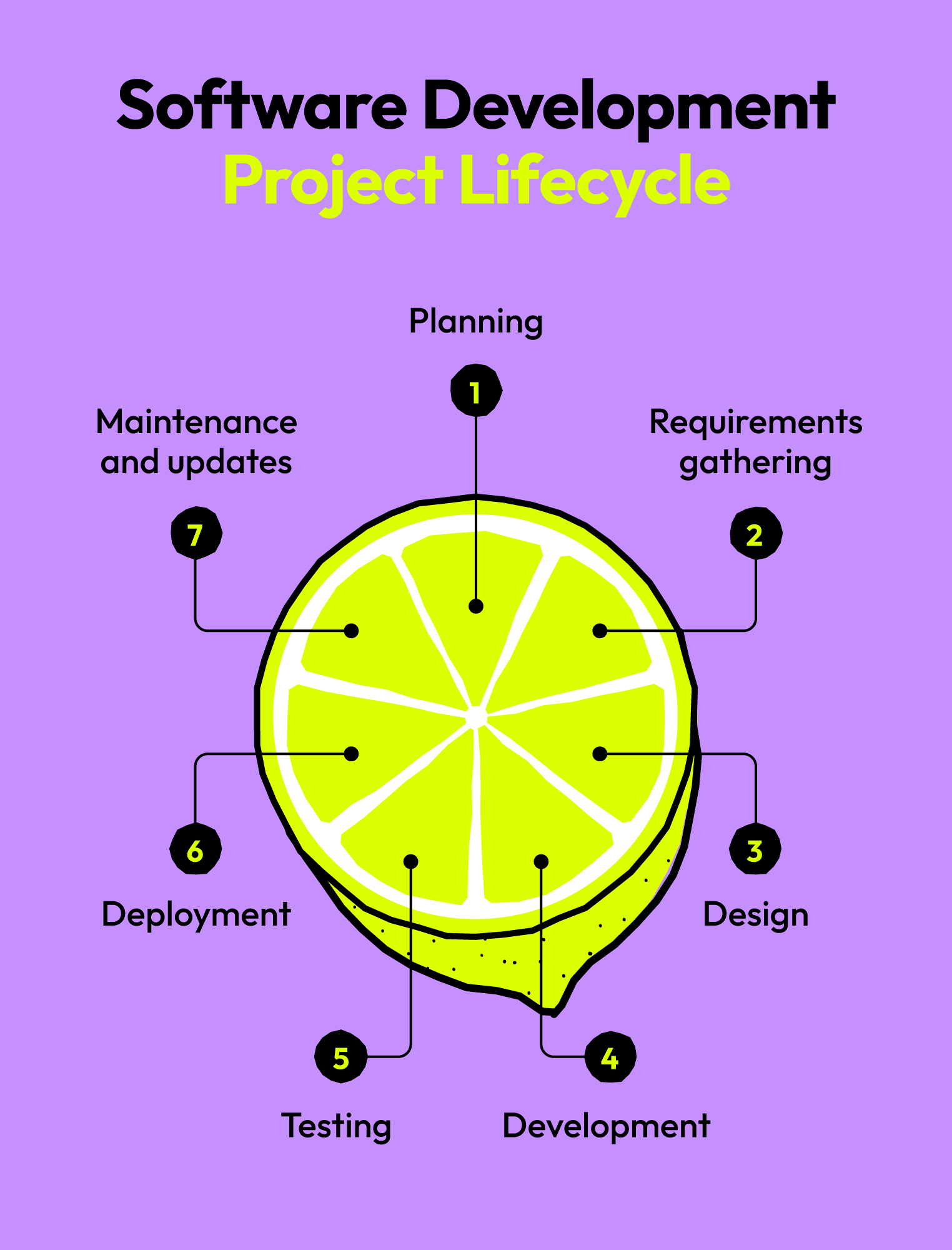
Types of Software Project Management
There are several popular types of project management methodologies, especially in tech, and each one offers a distinct approach. While you’ve probably already heard of Agile, some of these other lesser-known approaches may be new to you—and just what you need to streamline your next project.
Here’s an overview of some of the most prevalent software project management methodologies:
Agile
Born from the Agile Manifesto in 2001, Agile emerged as a response to the rigidness of traditional software development processes. Now widely adopted in tech, it’s useful even for nontech teams. It emphasizes iterative development, collaboration, and flexibility.
Agile methodologies prioritize delivering software frequently, rather than slow and inflexible production cycles. This fosters close communication between the development team and stakeholders, and makes quick pivots and adaptations based on changing needs easier.
Scrum
Scrum is a lightweight framework within the Agile umbrella tailored explicitly for software development teams. It structures the development process into short, iterative cycles called Sprints using specific:
- Roles (like Scrum Master)
- Events (like Sprints, Daily Scrum, or Sprint Planning)
- Artifacts (like Sprint Backlog)
Scrum focuses on maximizing team collaboration, self-organization, and continuous improvement.
XP (Extreme Programming)
Extreme Programming, or XP, is another flavor of Agile that focuses on cranking out high-quality software while getting the team to work closely together.
In XP, you might see practices like two people coding at one computer (pair programming), writing tests before code, or constantly merging code changes. Like other Agile approaches, XP is all about being able to roll with the punches as things change during development.
SAFe
SAFe was developed to address the challenges of scaling Agile principles and practices in large, enterprise-level software organizations. It provides a structured framework, enabling multiple Agile teams in a large organization to align with common business goals. Think of it as bringing Agile principles to the enterprise level.
Lean
Originating from the Toyota Production System in manufacturing, Lean principles focus on maximizing value while minimizing waste. It aims to eliminate unnecessary processes in software development for fewer delays and faster deliveries.
Kanban
Kanban, also from manufacturing, is a visual workflow management system that helps teams manage and improve workflow. It uses a board with columns representing different workflow stages and cards representing tasks. It’s a popular software tool, particularly in DevOps environments.
Waterfall
The Waterfall methodology, rooted in traditional construction and engineering projects, follows a linear, sequential flow. Ideally, you complete each project phase before the next one begins.
While offering a structured approach, Waterfall can be less flexible in accommodating changes once a phase is complete—especially compared to Agile methodologies.
PRINCE2
PRINCE2 is a structured project management methodology widely used in government and enterprise projects, including software initiatives. It provides a process-based approach with clearly defined roles, responsibilities, and stages. PRINCE2 emphasizes business justification, with a focus on product delivery.
Top Software Project Management Platforms
Choosing the right platform is critical to software project management success—and that’s an understatement. The right platform will help you plan smarter, manage tasks efficiently, and keep a close eye on everyone’s progress.
Let’s take a look at some of the types of project management software that teams are using today:
- Atlassian’s Jira: Primarily known for its robust issue tracking and agile project management capabilities, Jira is highly customizable and plays well with other developer tools.
- Wrike: Wrike is an adaptable platform offering project planning, resource management, and collaboration features—and you can use it with both agile and waterfall methodologies.
- Asana: Asana is a versatile task management workhorse. It’s easy to use, simplifies team collaboration, and offers a visually friendly interface that keeps everyone on the same page.
- Smartsheet: Combining a spreadsheet’s familiar interface with project management features, Smartsheet is well-suited for managing tasks, timelines, and budgets.
- Trello: For a straightforward and visual approach, Trello’s Kanban boards with lists and cards make it super easy to organize tasks and see where everything stands.
- TimeCamp: An enterprise-grade time-tracking and project management solution designed for large teams and complex workflows. It provides advanced reporting, automated time logging, and seamless integrations, helping organizations optimize resource allocation, monitor project progress, and ensure on-time, on-budget delivery.
- ClickUp: Looking for an all-in-one solution? ClickUp packs project management, task tracking, time management, and team collaboration tools into a single platform.
- Monday.com: Monday.com offers a really visual and adaptable way to manage projects and workflows, allowing teams to customize it to fit their specific needs.
- Zoho Projects: If you’re already in the Zoho ecosystem, their Projects platform provides a complete set of features, from task management to Gantt charts and issue tracking.
- Airtable: Airtable combines the flexibility of a spreadsheet with database-like features, making it a powerful tool for organizing and tracking project workflows.
Software Project Management Metrics
When it comes to project management, metrics are everything. Metrics give you a real picture of how well the project is performing, the quality of what you’re building, and the efficiency of your processes.
Here are some of the most common metrics tracked and measured in software project management:
Project Performance
First, let’s talk about how to keep tabs on whether your project is hitting its marks in terms of time and money:
- Schedule variance: Schedule Variance (SV) compares the planned work completion date to the actual completion date to determine if a project is ahead of or behind schedule.
- Cost variance: Looks at the budgeted cost of work performed in contrast with the actual cost, revealing whether the project is over or under budget.
- Earned value: Earned value is the budgeted cost of the work that is already complete.
- Productivity: Measures the output of a development team against the effort involved to determine the team’s efficiency.
- Resource utilization: Indicates the percentage of available resources (like personnel) actively used on the project. It can also help you determine if you need to work with additional freelance development talent.
- Customer satisfaction: Gauges the level of satisfaction among the project’s stakeholders or end-users with the delivered product or the project process.
- Return on investment (ROI): Calculates the project’s profitability by comparing the net profit generated to the total investment made.
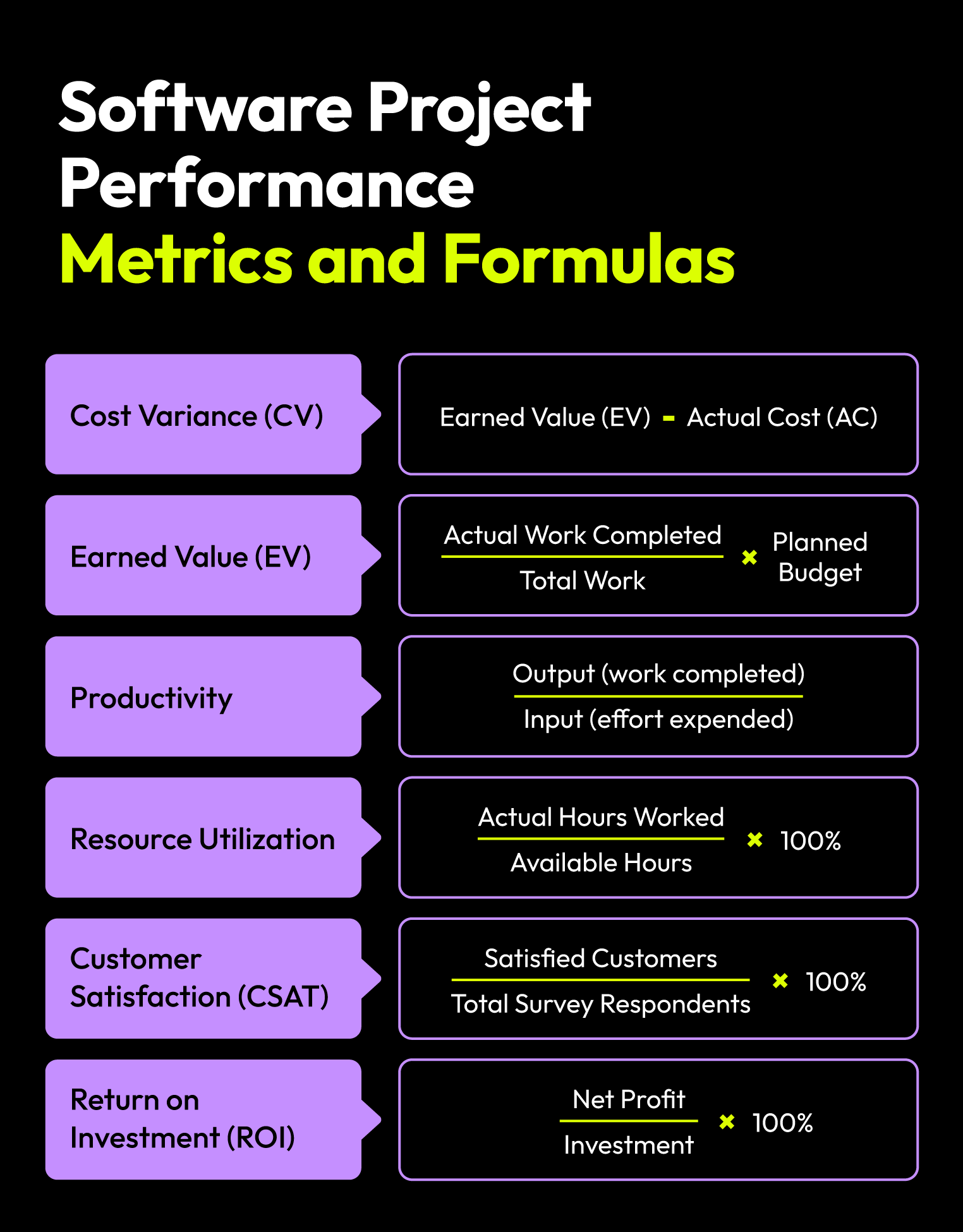
Quality Metrics
Next, we’ll cover quality metrics. These metrics assess the caliber of your software and whether it will meet consumer expectations.
- Defect density: Measures the number of defects identified in the software relative to its size.
- Code coverage: This shows how much of your actual code is being checked by your automated tests.
- Usability: Is your software easy and intuitive for people to use? This metric helps you gauge the user experience.
- Maintainability: Reflects the ease with which the software can be modified, enhanced, or repaired.
- Defect rate: This tracks how often you’re finding bugs over time. (This should decrease over time, ideally.)
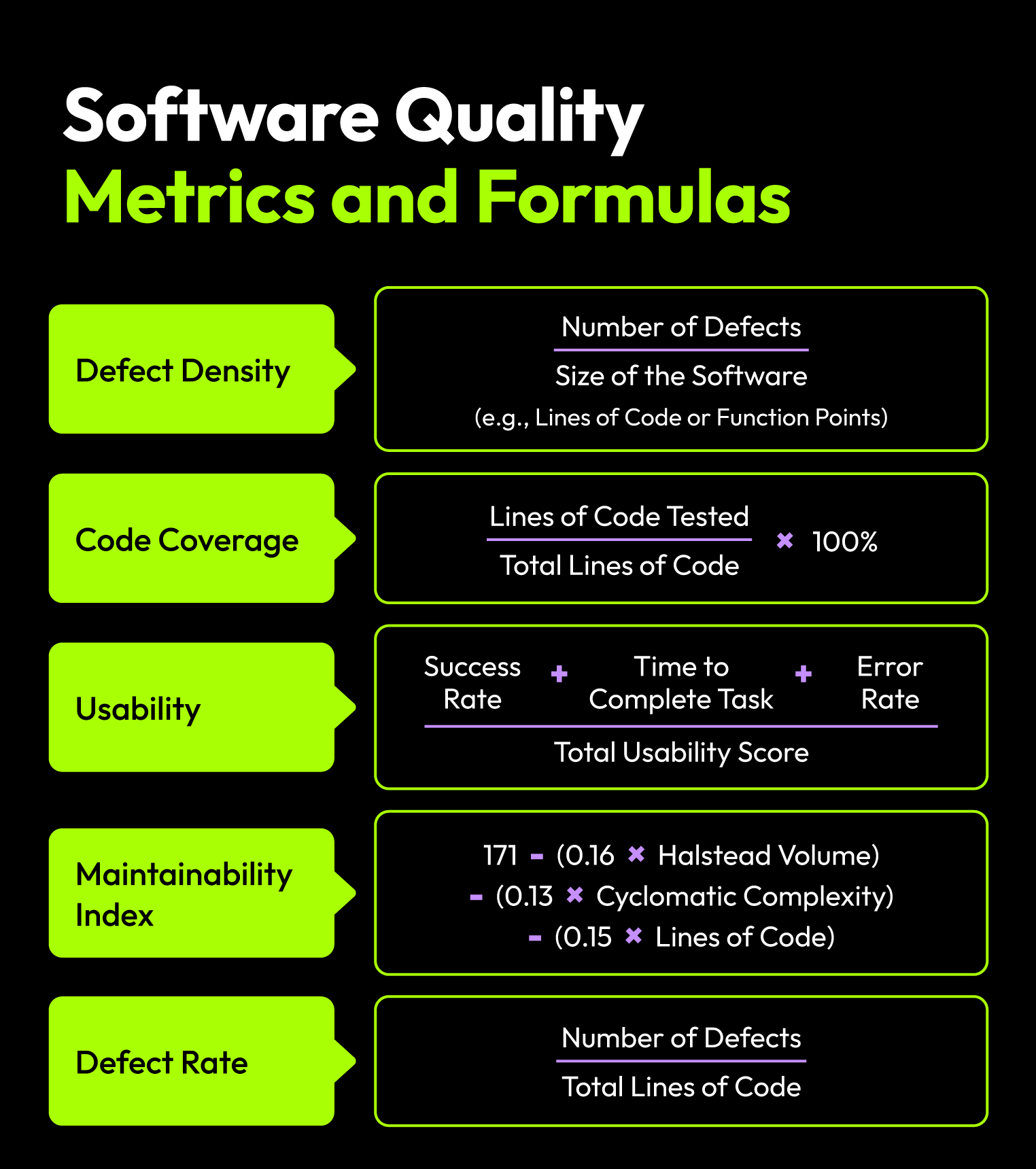
Process Metrics
Next, you’ll want to evaluate the efficiency and effectiveness of the software development process itself.
To do this, you might look at metrics like these:
- Development velocity: Especially relevant if you’re using Agile, this shows you how much work your team can knock out in a set timeframe, like a sprint.
- Cycle time: This is the average time it takes for a task or a new feature to go from “let’s do this” to “it’s done.”
- Deployment frequency: Tracks how often the software is successfully deployed to a production or staging environment.
- Change failure rate: This tells you what percentage of your software updates or changes cause problems and need to be rolled back.
- Mean Time to Repair (MTTR): Measures the average time to fix a failed component or restore service after an incident.
- Lead time: This tells you the total time from when a request is made for a new feature (or bug fix) until it’s delivered.
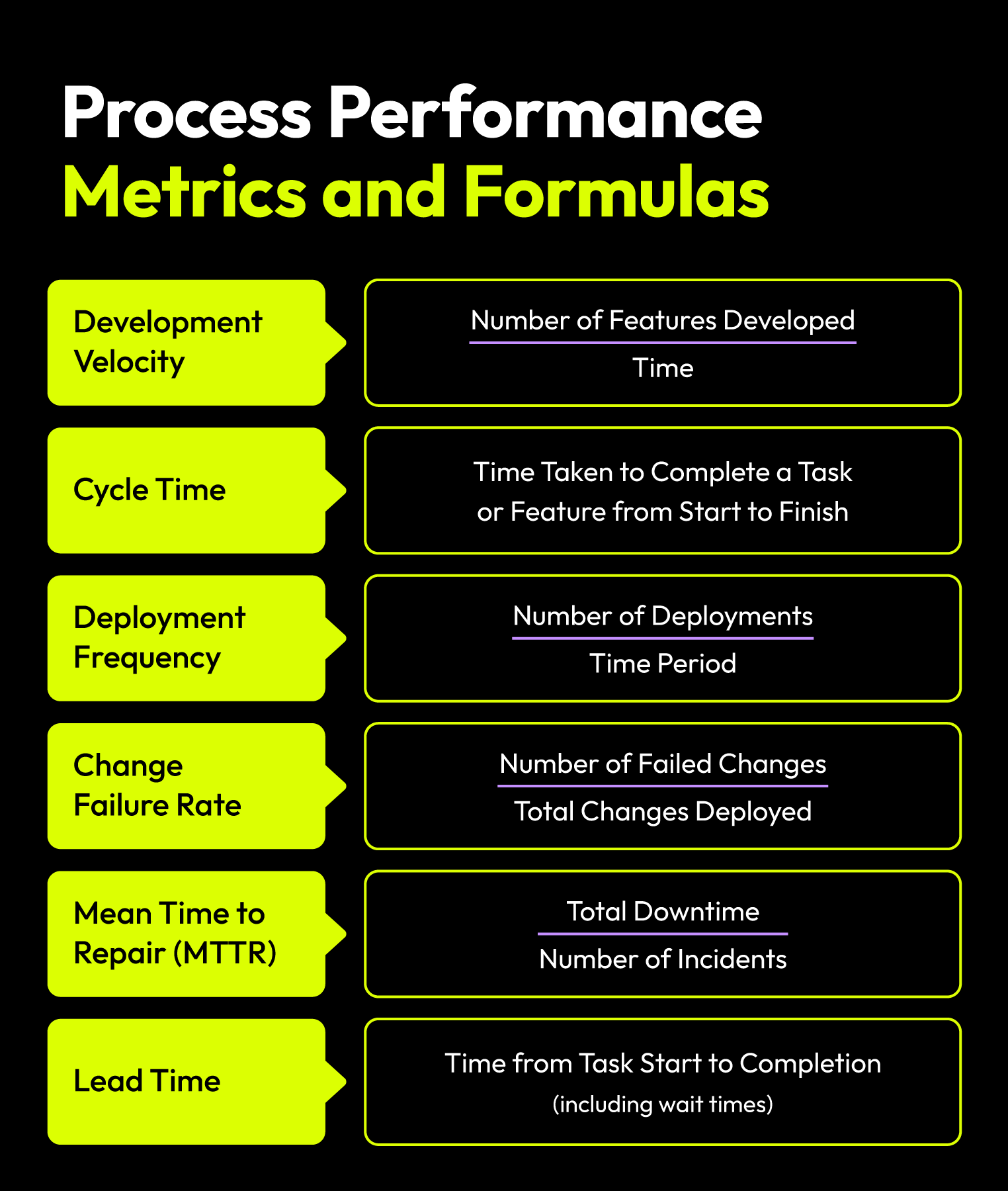
Agile Metrics
Specifically for Agile methodologies, these metrics help teams track their progress within sprints. These metrics can include:
- Story points completed: Represents the total number of story points the development team completed within a single sprint, indicating the team’s capacity.
- Scope completion ratio: Did you actually finish what you planned for the sprint? This metric shows the percentage of scheduled stories that made it to “done,” highlighting your team’s predictability.
- Scope added after sprint start: Tracks the number of story points or user stories added to the sprint backlog after the sprint commenced—indicating potential scope creep.
- Workflow metrics: These numbers describe how smoothly tasks move through your development process. (Think things like Cycle Time and Lead Time, which can help you spot any slowdowns.)
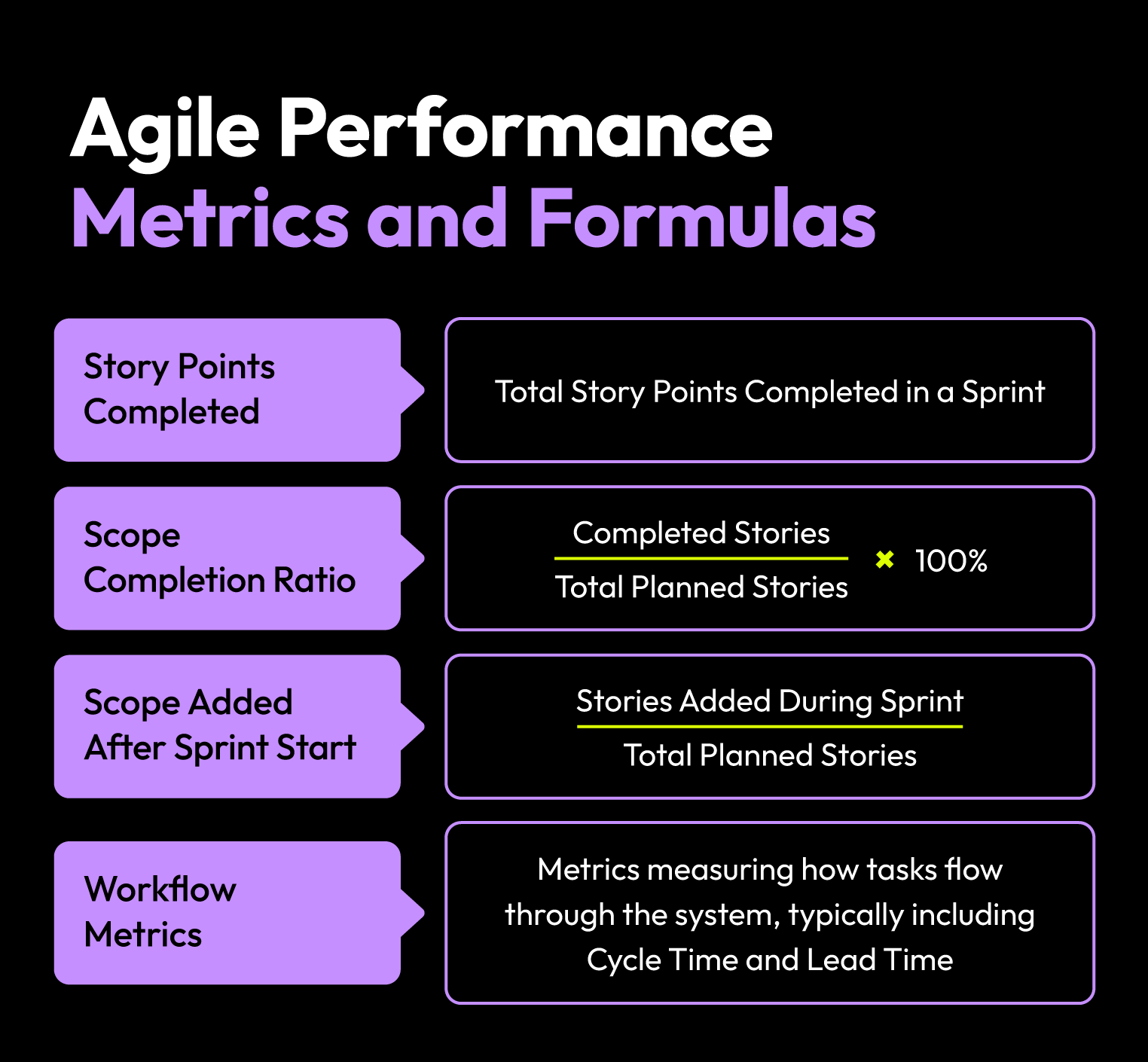
Business Metrics
While not directly tied to the development process, it’s worth considering how the software product affects overall business success. Some commonly-tracked business metrics include:
- Retention rate: Retention rate tells you how sticky your product is. Retention is the percentage of users sticking around—while churn is the percentage leaving.
- Number of active users: How many people use your software within a specific timeframe? This shows its reach and adoption.
- Customer acquisition rate: Customer Acquisition Rate, or CAR, refers to the rate at which a business acquires new customers over a specific period.
- Conversions: This looks at how many users are taking a specific action you want them to, like signing up or buying something. It’s often shown as a percentage, like “10% conversion rate”.
- Customer lifetime value (CLV): Estimates the total revenue a single customer is expected to generate for the business over their entire relationship with the product.
- Monthly recurring revenue (MRR): If you have a subscription model, this is the predictable revenue you’re bringing in each month.
When you’re thinking about how to use project management software, considering the business metrics your performance will be evaluated on is a good place to start.
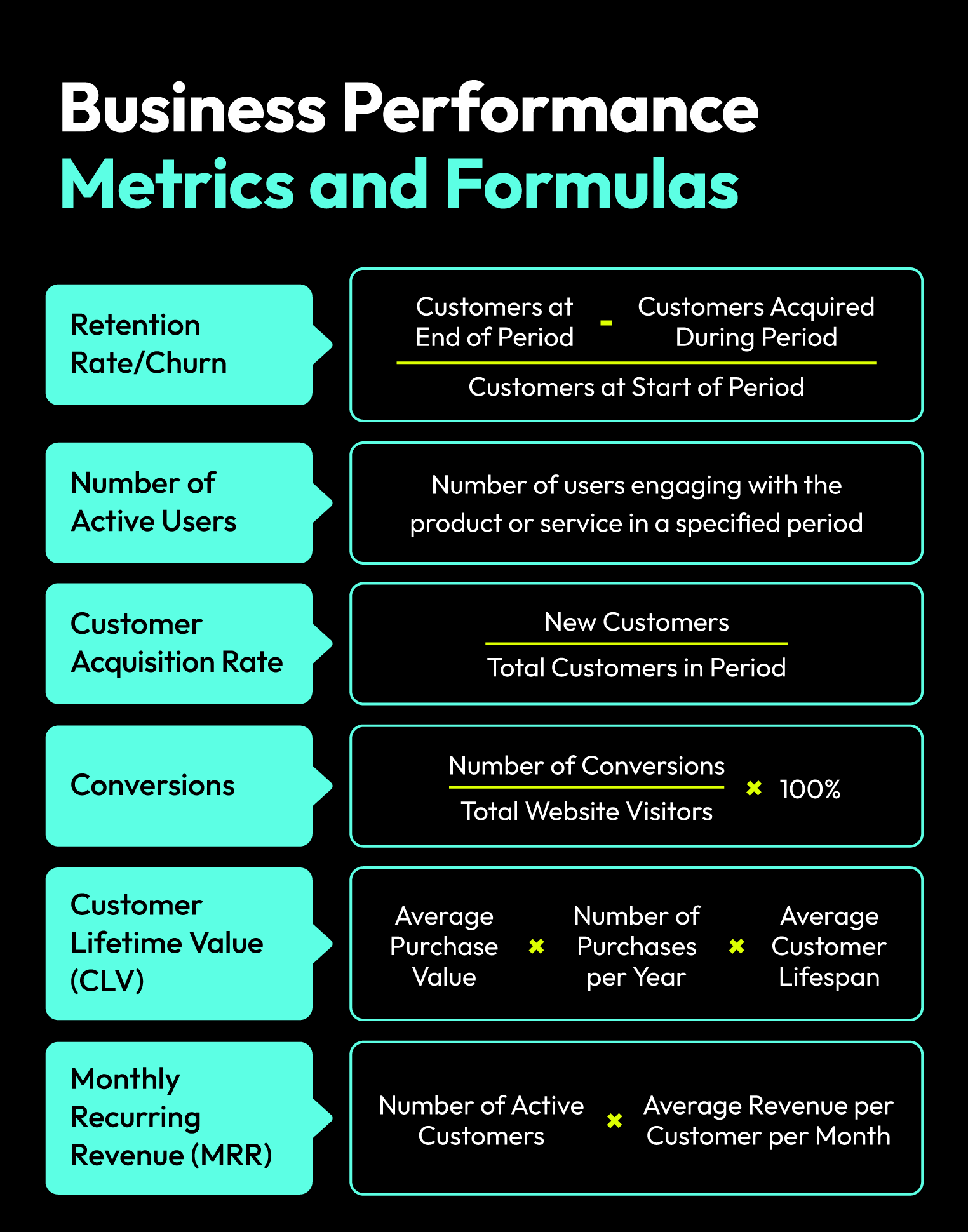
Challenges That Impact Software Project Management
Whether we like it or not, navigating software projects often involves jumping some hurdles and/or untangling some knotty issues.
These roadblocks could include some of these likely suspects:
- Unclear requirements: Constant changes in project objectives and uncertainty about the final product can result in significant delays and wasted effort.
- Poor communication: If your team, stakeholders, and clients are not aligned, things can quickly go awry—expect misunderstandings and unmet expectations.
- Scope creep: Expanding a project’s scope beyond the initial agreement can lead to increased costs, extended timelines, and resource strain.
- Integration issues: Getting different software components to work together seamlessly can be a time-consuming headache.
- Limited resources: Not having enough budget, personnel, or the right tools can seriously hinder your progress and force some tough choices that impact your project’s speed and quality. This is where thoughtful resource planning and finding the right talent become super critical.
Tips for Software Project Managers
Effective software project management relies on a combination of strategic planning, strong leadership, and proactive problem-solving. If you’re a software project manager looking to up your game, implementing these key strategies may help.
- Clearly define scope: Nail down precisely what the project will and won’t include right from the start. Get it in writing and ensure everyone is on the same page to avoid surprises later.
- Utilize project management tools: These are lifesavers for keeping things organized, tracking tasks, and ensuring everyone knows their responsibilities and deadlines. Consistent use is key for smooth teamwork.
- Prioritize communication: Keep those communication lines open and honest with everyone involved. Regular updates and clear feedback can help prevent many problems.
- Monitor key metrics: Identifying issues such as schedule delays or budget overruns early allows you to address them before they become major problems.
- Adapt to change as needed: Things change, especially in software. Being flexible and ready to adjust your plans when necessary is a hallmark of a good project manager. Just make sure you’re also managing how those changes affect the project.
- Source top talent: Utilizing platforms that specialize in connecting businesses with experienced professionals can—despite the fluctuating development statistics about the state of the software talent pool—significantly enhance the quality of the dev team.
For businesses seeking to augment their development teams with top-tier, pre-vetted engineers, Lemon.io offers a streamlined platform to efficiently source and hire the specialized talent needed to drive successful software project outcomes.
Level-up Your Software Project With Lemon.io
Even the most adept project manager relies on a skilled development team to execute the project vision successfully. An experienced development team can efficiently produce high-quality software and help project managers meet deadlines and exceed expectations.
Ready to take your software projects to the next level? Don’t let talent gaps hold you back. Explore Lemon.io’s curated pool of top-tier software developers today and build the exceptional team you need to achieve your goals.










